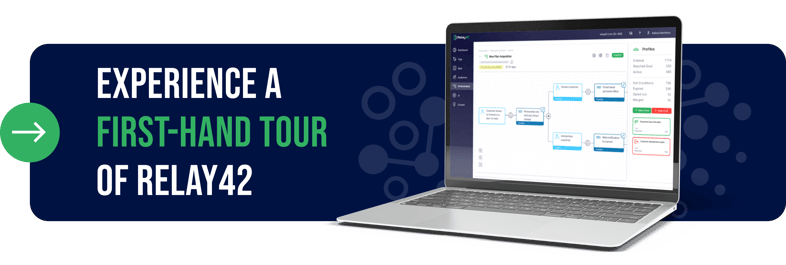CDPs vs. DMPs - What Are the Differences?
by Kalina Dancheva on 21.10.2021

CUSTOMER DATA PLATFORM VS DATA MANAGEMENT PLATFORM
Modern consumers are hard to woo. They’re bombarded with ads — up to 10,000 a day — most of which they automatically relegate to background noise or vaporize via ad blocker.
Innovative tools, including customer data platforms (CDP) and data management platforms (DMP), help marketing professionals cut through the static and produce compelling hyper-personalized messages. But which one do you need — a CDP or a DMP?
In this guide, we’ll compare and contrast customer data platforms and data management platforms to find out which option is the most useful, and which is the most sustainable in light of the upcoming ‘cookie apocalypse.’
To survive in a third-party cookie-free world, AdTech companies and marketers have to adapt: they have to learn how to paint similar (or better) consumer profiles using different data. That’s where MarTech platforms come in.
WHAT IS A CUSTOMER DATA PLATFORM?
Customer Data Platforms, or CDPs, build detailed customer profiles by integrating data from predominantly first-party data sources. Marketers then use these consumer profiles to better understand their potential customers, and to craft highly effective hyper-personalized marketing campaigns.
According to CDP Institute founder David Raab, a customer data platform is a “marketer-managed system that creates a persistent, unified customer database that is accessible to other systems.”
Discover what Customer Data Platforms are further via this resource.
WHAT IS A DATA MANAGEMENT PLATFORM?
Data management platforms store, organize and interpret consumer data from a range of mostly second and third-party sources. DMPs are designed to work with mostly anonymized data — third-party cookies, for instance — rather than ‘owned’ data. Advertising agencies mainly use DMPs to improve ad targeting.
“DMPs are designed primarily to manage audiences for online advertising,” describes Raab. “As such, they deal mostly with anonymous data that becomes obsolete quickly.”
CUSTOMER DATA PLATFORMS vs DATA MANAGEMENT PLATFORMS
CDPs and DMPs are both platforms designed to gather and redistribute data. Both tools help companies profile customers and design advertising strategies to increase customer acquisition or improve customer retention. After that, CDPs and DMPs behave quite differently.
In the following sections, we’ll explore how CDPs and DMPs handle different data types, and how they function in different scenarios.
DMP VS CDP: DATA COLLECTION
|
DMPs rely on second and third-party data. DMPs collect a range of anonymous second and third-party data types, including third-party cookies. They typically do this in two different ways:
Arguably the biggest drawback of any DMP is its reliance on third-party data. When support for third-party cookies vanishes, DMP analysis and forecasting will become unsustainable. |
CDPs collect first-party data. Most major browsers will stop supporting third-party tracking cookies by 2023. Thankfully, CDPs don’t rely on third-party data. Instead, they focus predominantly on personally identifiable information (PII) gathered from sources like:
CDPs collect a wide range of first-party demographic, transactional and behavioral data. Some also weave second and third-party data into the mix. The very best CDPs utilize built-in privacy rules to ensure that their owners stay data-compliant. |
DMP VS CDP: CONSUMER INSIGHTS
|
DMPs are focused on pre-defined audiences. DMPs collect, analyze and extrapolate simple audience data, and at most, they use logical systems to combine those audiences. DMPs don’t, however, consider full individual profiles and past behavior in real-time.
|
CDPs provide a 360-degree customer view. Feature-rich CDPs focus on first-party data and enrich insights with second and third-party data. This all-encompassing strategy gives marketers a singular 360-degree customer view. Rather than targeting broad audience-based consumer segments, marketing professionals can target customers on a personal level based on dynamic behaviors. As consumer profiles get more complex, creative assets follow suit. |
DMP VS CDP: CUSTOMER JOURNEY CURATION
|
DMPs influence ad targeting in real time. DMPs aren’t good at handling or interpreting unstructured data — rich media, IoT sensor data, or AI-generated data, for instance. Because of their limited data interpretation capabilities, DMPs can’t assist marketers with customer journey implementation. Instead, they’re used to influence ad targeting to ensure that marketing messages reach the right audience segments. |
CDPs support active personalization in real-time. CDPs support active personalization in response to every customer interaction — no matter how small. When consumers don’t click on a linked email ad, for instance, that failure to respond gets recorded. Non-responsive consumers might then see a browser ad or an ad on social media. AI-enhanced CDPs use an enormous breadth and amount of data to hyper-personalize the consumer experience. These groundbreaking CDPs act like digital brains, taking data and directing consumers into the sales funnel at any stage. In essence, they’re holistic marketing tools. |
DMP VS CDP: CROSS-CHANNEL MARKETING
|
DMPs manage remarketing tags and simple data. Because they’re tailored to respond to ads, DMPs aren’t as flexible as CDPs. DMPs are designed to store simple, rather than complex data, and to hone targeted ad campaigns quickly. As such, they can tackle many IDs at once, and can gather, sort and manage remarketing tags, including smart tags. Some DMPs also support real-time programmatic ad bidding. |
CDPs help organisations share data across channels. Many organisations run multiple marketing campaigns at the same time. When these happen in different departments, employees have to spend a lot of time and energy communicating strategy, sharing data and onboarding new team members. CDPs make cross-channel marketing easier by unifying multi-channel and crosschannel marketing efforts with consolidated, accurate data, both for own and paid media channels. At the same time, they collect and organize new data to redefine ongoing campaigns and inspire fresh campaigns. |
WHAT MAKES THE RELAY42 PLATFORM DIFFERENT?
Relay42 is a best-of-breed CDP-based Journey Orchestration platform enhanced with AI. In other words, it’s a native CDP built from the ground up to utilize first-party data. Unlike standard CDPs, Relay42 connects to offline data sources, unifies all media channels, and applies advanced AI in real-time on a one-to-one basis.
Because Relay42 integrates cutting-edge DMP capabilities, it also handles second and third-party data in addition to first-party data. This means that marketers can orchestrate both owned and paid media streams to create seamless customer journeys.
With Relay42, you can:
- Orchestrate consumer journeys across channels
- Use industry-specific AI models to hone your marketing campaigns
- Personalize every single consumer touchpoint
- View all customer data in one centralized location
- Activate dynamic content automatically
- Connect your existing in-house intelligence and AI models to the platform via API
CREATE MEANINGFUL, REAL-TIME CONSUMER CONNECTIONS WITH RELAY42
Relay42 Journey Orchestration represents the next level in CDP development. We build and implement industry-specific AI-enhanced CDPs that evolve along with the companies they serve. With a Relay42 CDP in place, you can increase your marketing ROI and turn existing customers into brand advocates.
To learn more about groundbreaking Relay42 products and services, get in touch with us today.
You May Also Like
These Related Stories

How to Work With Zero, First, Second and Third-Party Data on a CDP

Looking for a DMP? Ask Yourself These 5 Questions First
.jpg)

